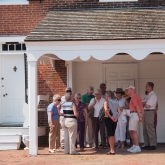Pump House
The Pump House c. 1780 was built by William Corbit as housing for his tannery employees.
The 18th century Cantwell’s Bridge was a rapidly growing community and the south side of Main Street was already heavily developed by 1780. This type of row construction was typical of Philadelphia and larger cities of the period and represented solidly built middle-class housing.
An 18th century jailhouse?
It is reputed that south side of the Pump House served as the town jail. While the town is not known to have had a sheriff in the 18th century, the jail may have been used as an overnight lock-up awaiting transport to New Castle. Through the basement bulkhead door, an offending unruly rowdy from the tavern across the street or perhaps a fugitive slave might have spent the night locked up there. The jail room has a heavy door and a sunken post in the floor possibly used to attach the manacles of a prisoner.
The wood water pump in front of the house is indicative of the public nature of the center of town. The pump was a necessity for thirsty travelers who otherwise would have had to beg a drink from a resident or purchased it at a livery stable or tavern.







